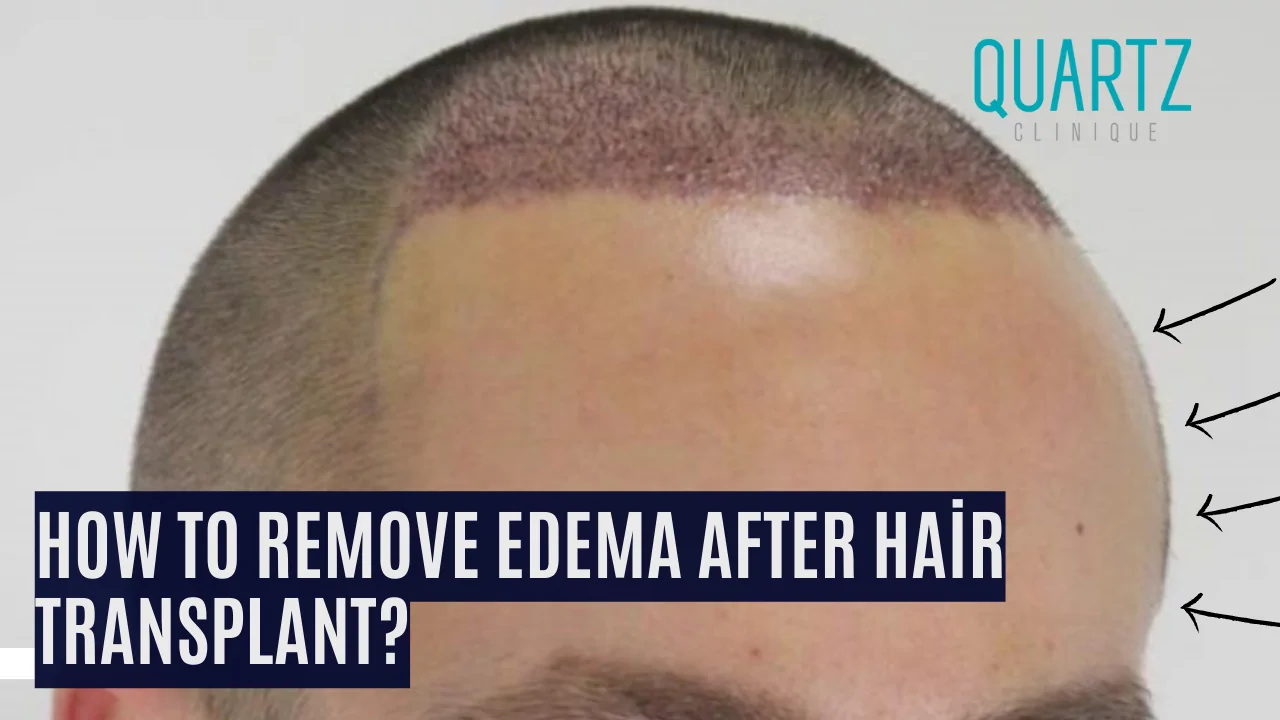Mild swelling, known medically as edema, is one of the most common temporary side effects after hair transplantation. It usually appears within the first few days following surgery — especially on the forehead and around the eyes — and tends to resolve naturally within a few days.
While this swelling is not dangerous, it can cause discomfort or temporary cosmetic concern. Fortunately, there are several effective ways to reduce edema after a hair transplant and promote faster recovery.
At Quartz Hair Clinic in Istanbul, our surgeons provide detailed aftercare instructions to minimize swelling, speed up healing, and ensure the most natural-looking results.
What Causes Edema After Hair Transplant?
Swelling occurs as part of the body’s natural healing response to surgical trauma. During hair transplant surgery (such as FUE or DHI), small incisions are made in the scalp to insert grafts. The body reacts by increasing fluid and blood flow to the area to protect and heal the tissue.
Several factors can contribute to swelling after a hair transplant:
- Local anesthesia: During the procedure, anesthesia fluid is injected under the scalp. As this fluid disperses post-surgery, it can move downward, causing temporary puffiness in the forehead and around the eyes.
- Inflammatory response: The immune system sends white blood cells to repair tissue, which may lead to short-term swelling.
- Gravity and skin elasticity: In some patients, especially those with loose skin or older age, fluids tend to collect around the eyes or forehead.
- Duration of surgery: Longer procedures may increase fluid retention, slightly intensifying post-op swelling.
Is Swelling After Hair Transplant a Sign of a Problem?
In most cases, edema is completely normal and harmless. It typically peaks around the third or fourth day after surgery and fades away by the end of the first week.
However, persistent swelling accompanied by symptoms such as pain, pus, itching, or fever could indicate infection or another complication. In such cases, contact your surgeon immediately.
Avoid driving or operating machinery if swelling affects your vision. Most patients can safely resume their daily activities once swelling subsides.
How Common Is Edema After Hair Transplant?
Studies show that approximately 50–55% of hair transplant patients experience some degree of swelling.
Those who follow post-operative care instructions or receive steroid prophylaxis often experience milder symptoms.
In short, it’s a common but temporary side effect — not a sign of a failed or “botched” procedure.
Timeline of Swelling After Hair Transplant
| Day | What Happens | Recommended Care |
|---|---|---|
| Day 1–2 | Mild forehead tightness may appear as anesthesia begins to wear off | Keep head elevated, avoid touching or bending forward |
| Day 3–4 | Swelling may shift to the forehead and around the eyes | Apply cold compresses, avoid exercise or sauna |
| Day 5–7 | Swelling begins to subside gradually | Drink plenty of water and follow your doctor’s medication plan |
| After Day 7 | Most swelling disappears; only minor puffiness may remain | Resume normal activities, continue gentle washing and care |
Effective Ways to Reduce Edema After Hair Transplant
Even though swelling is self-limiting, the following methods can significantly reduce edema and discomfort after a hair transplant.
1. Apply Cold Compresses
Use an ice pack or cold compress on your forehead and around the eyes (not directly on the transplanted area).
Apply for 10 minutes several times a day to constrict blood vessels and reduce puffiness.
2. Sleep with Your Head Elevated
For the first 3–5 days, sleep with your head raised at a 45° angle using extra pillows or a recliner chair.
This prevents fluid from collecting in the forehead area and speeds up drainage.
3. Stay Hydrated
Drink 2–3 liters of water daily. Hydration helps the body eliminate anesthesia fluid and reduce inflammation.
Dehydration can worsen swelling and slow healing.
4. Use Steroid or Anti-Inflammatory Medication (If Prescribed)
Your surgeon may prescribe steroid tablets or topical medication to minimize swelling. Take them exactly as directed.
Avoid Ibuprofen, as it can cause water retention — instead, use paracetamol for pain relief.
5. Gentle Forehead Massage (If Approved by Your Surgeon)
After a few days, you can gently sweep the forehead from the center toward the sides using your fingertips.
This encourages lymphatic drainage and helps remove excess fluid.
6. Avoid Exercise and Sweating
For at least three days after surgery, avoid physical activities that cause sweating or increase blood pressure.
Exercise can worsen swelling or disturb grafts in the early recovery phase.
What If Swelling Doesn’t Go Away?
If edema lasts longer than 10–14 days, becomes painful, or affects your vision, contact your hair transplant surgeon immediately.
Prolonged swelling may indicate an infection or an allergic reaction, requiring professional evaluation.
Your doctor may recommend:
- A short course of corticosteroids
- Topical cooling gels or ointments
- Additional hydration and rest
Avoid self-medicating with over-the-counter anti-inflammatory drugs unless specifically approved by your surgeon.
Quick Tips to Prevent Swelling After Hair Transplant
💧 Hydrate properly — drink plenty of water before and after surgery.
💤 Sleep elevated for the first week.
❄️ Use ice compresses gently on the forehead (never on grafts).
🚫 Avoid alcohol and smoking for at least three days post-surgery.
🏃♂️ Refrain from intense workouts until your doctor approves.
💊 Follow your medication schedule as prescribed by your surgeon.
Edema after hair transplant is a natural, temporary reaction that typically resolves within a few days.
By carefully following your surgeon’s instructions, maintaining hydration, and applying simple preventive measures, you can minimize swelling and recover more comfortably.
At Quartz Hair Clinic in Istanbul, our expert surgeons and aftercare team are committed to ensuring that each patient experiences a smooth, safe, and comfortable recovery following hair transplantation.

